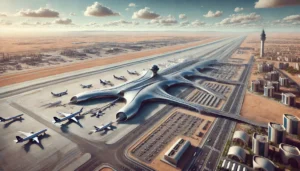The World’s Largest Airport: A Gateway to the Future
 The World’s Largest Airport: A Gateway to the Future
The World’s Largest Airport: A Gateway to the Future
Airports are more than transit hubs; they are gateways connecting nations, cultures, and economies. Among them, one stands out for its sheer size, innovation, and functionality: King Fahd International Airport (KFIA) in Dammam, Saudi Arabia. With an area of 780 square kilometers (300 square miles)—nearly the size of New York City—it holds the title of the world’s largest airport by land area.
Let’s dive into what makes this colossal airport a marvel of modern engineering and a glimpse into the future of aviation.
The Scale of King Fahd International Airport
Located in the Eastern Province of Saudi Arabia, KFIA was inaugurated in 1999 and has since been a benchmark for large-scale infrastructure. Its staggering size isn’t just about runways and terminals; the airport includes residential areas, recreational spaces, and future expansions for industrial zones.
To put it in perspective:
- Runways: KFIA has two parallel runways, each 4,000 meters (13,123 feet) long, accommodating the largest aircraft in the world.
- Passenger Capacity: Although not as busy as airports like Hartsfield-Jackson in Atlanta, KFIA has a capacity to handle millions of passengers annually.
- Dedicated Spaces: The airport houses the Royal Terminal for Saudi royals and VIPs and ample space for cargo operations, making it a hub for business and logistics.
Beyond the Numbers: Innovative Features
1. Architecture and Design
The main terminal of KFIA is a blend of modern and traditional Arabian architecture. It features wide-open spaces, geometric designs, and luxurious interiors. The design focuses on passenger comfort, with spacious lounges, high-end shopping, and a variety of dining options.
2. Sustainability Initiatives
Despite its size, KFIA has made strides in implementing sustainable practices, such as energy-efficient lighting and water conservation systems. As Saudi Arabia invests heavily in green initiatives through its Vision 2030 plan, the airport is expected to integrate more eco-friendly technologies in the coming years.
3. Strategic Location
Situated near major oil fields and industrial zones, KFIA plays a crucial role in supporting the region’s economy. It connects the Middle East to Asia, Africa, and Europe, serving as a strategic hub for international flights and cargo.
How Does It Compare Globally?
While KFIA is the largest by land area, other airports shine in different ways:
- Busiest by Passenger Traffic: Hartsfield-Jackson Atlanta International Airport (ATL) in the USA.
- Largest Terminal Building: Beijing Daxing International Airport in China boasts the world’s largest single-terminal building.
- Busiest International Airport: Dubai International Airport (DXB) leads in international passenger traffic.
The Future of KFIA
Saudi Arabia’s Vision 2030 includes significant plans for infrastructure development, tourism, and global connectivity. KFIA is set to benefit from these initiatives, with potential expansions to accommodate futuristic aviation technologies, such as urban air mobility (UAM) and advanced cargo handling systems.
As air travel continues to evolve, King Fahd International Airport remains a testament to human ambition and ingenuity. It’s not just the largest airport—it’s a symbol of what’s possible when vision meets action.
What are your thoughts on the world’s largest airport? Have you experienced its grandeur firsthand? Let us know in the comments below!
https://zireemilsoude.net/4/8595583
https://www.profitablecpmrate.com/u52jhwjgr?key=967b290a9b0ec20908866d24dc3c66f9
https://monetag.com/?ref_id=u6F4







